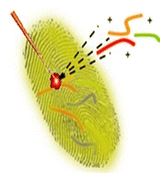 Ekta Patel, Malcolm R. Clench, Andy West, Peter S. Marshall, Nathan Marshall and Simona Francese
Ekta Patel, Malcolm R. Clench, Andy West, Peter S. Marshall, Nathan Marshall and Simona Francese
J Am Soc Mass Spectrom. 2015 Jun;26(6):862-72. Epub 2015 Apr 28.
Despite recent improvements to in situ proteolysis strategies, a higher efficiency is still needed to increase both the number of peptides detected and the associated ion intensity, leading to a complete and reliable set of biomarkers for diagnostic or prognostic purposes. In the study presented here, an extract of a systematic study is illustrated investigating a range of surfactants assisting trypsin proteolytic activity. Method development was trialled on fingermarks; this specimen results from a transfer of sweat from an individual’s fingertip to a surface upon contact. As sweat carries a plethora of biomolecules, including peptides and proteins, fingermarks are, potentially, a very valuable specimen for non-invasive prognostic or diagnostic screening. A recent study has demonstrated the opportunity to quickly detect peptides and small proteins in fingermarks using Matrix Assisted Laser Desorption Ionization Mass Spectrometry Profiling (MALDI MSP). However, intact detection bears low sensitivity and does not allow species identification; therefore, a shotgun proteomic approach was employed involving in situ proteolysis. Data demonstrate that in fingermarks, further improvements to the existing method can be achieved using MEGA-8 as surfactant in higher percentages as well as combinations of different detergents. Also, for the first time, Rapigest SF, normally used in solution digestions, has been shown to successfully work also for in situ proteolysis.


No responses yet